Home » History of Vietnam » Early History » Ascending Dragon
Ascending Dragon
This is a section of the book,
Land of the Ascending Dragon
Rediscovering Vietnam
It can be purchased from
Amazon.com – by clicking on
the book cover at right
Photographs – by Steve Raymer
Text by – Paul Martin
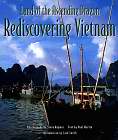
The Cradle Of Culture – Hue And Danang
THE PLATFORM at the Hue train station was vaulted by a dome of the deepest blue sky. In traveling nearly halfway down the coast we’d left behind the perpetually gray days I’d grown used to. But by trading in those deepest skies, we’d also given up the moderate temperatures of the north. It was hot now, though not quite the stifling heat I remembered from my year in Saigon.
Outside the station, Clang led the way toward a well-traveled gold Peugeot station wagon parked in a patch of shade. A slender man in a natty sport shirt and sunglasses stood beside the car–Ngoc, the driver for the next leg of my journey. Ngoc had a neat black mustache and a wry expression, and we found we were able to speak to each other in snippets of English and French.
The ride from the train station to the hotel was a short one, straight up Le Loi Street along the southeast bank of the wide, clear Perfume River. We were in the New City, as this section of Hue is called (at one time it was known as the European Quarter). Across the river, in the old part of Hue, loomed the gray stone walls of the Citadel, the moated fortress-city built by Cia Long, the first emperor of the Nguyen dynasty, Vietnam’s last imperial family. Cia Long moved the royal capital to Hue from Hanoi in 1802, after reuniting the country for the first time in two centuries. Me and 12 of his descendants ruled from here until 1945, when Emperor Bao Dai abdicated to a delegation dispatched by Ho Chi Minh. (Now in his 80s, Bao Dai is still living out half a century of exile in France.)
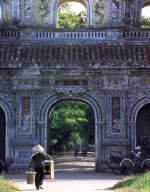
Set amid gentle hills some ten miles inland from the coast, Hue has been celebrated for centuries as Vietnam’s center of culture, education, and religion. It’s the city of lovers and kings, where history has been both kind and cruel. The very names Hue and the Perfume River conjure up romantic images of warm nights when couples drift in pleasure sampans, of a mighty empire fallen asunder, the tombs of its royalty slumbering in the jungly green countryside below the Imperial Screen Mountain. Hue is the gentle soul of Vietnam, a prosperous, tourist-oriented city of around 250,000 people–much cleaner than other Vietnamese cities, with air that’s still breathable.
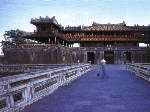
On the way to my hotel we passed the two bridges that join the new city and the old–Phu Xuan and Trang Ten-temporal links, in effect, between the present and past. Gliding over the first bridge were flocks of dainty teenage schoolgirls; they rode their bicycles with a dignified decorum, sitting ramrod straight and holding the tails of their ao dal to keep them from catching in their spokes–as if their sole purpose in life was to cut the most striking figure possible. (Among its many assets, Hue claims to have Vietnam’s most beautiful women). Just beyond the second bridge are two of the city’s top hotels, the Century Riverside Inn and the Huong Clang. I was booked into the newer Century Riverside. The spacious and spotless second-floor room I was shown to came as a shock after the cramped, frayed quarters on the train: My bathtub was bigger than the bed I’d slept in the night before (and actually more comfortable).
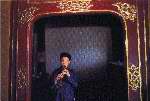
From the sunny veranda outside my room, I looked across the Perfume River to the low line of buildings that fringe the waterfront. Along Tran Hung Dao Street, between the river and the walls of the Citadel, was the two-story Dong Ba Market, Hue’s main trading center. A flotilla of sampans was strung out along the shore below the market. Each evening toward sunset, just before the lights of the city come on, those boats become black silhouettes on the crimson flood. The strains of Vietnamese music sometimes drift across the water from the floating communities, and as darkness settles over the river, the lights of the sampans become golden pinpoints.
Giang and I crossed to the other side of the river on the way to explore the Citadel, a sprawling testament to the one-time power and glory of Vietnamese royalty. In its flower the Citadel was the Vietnamese equivalent of Beijing’s Imperial City. Everything about the place was conceived on a grand scale. Begun in 1804, the capital complex spread over some 1,300 acres. It was enclosed by a 75-foot-wide moat and 20-foot-high stone walls that totaled more than six miles in length.
Inside the main walls of the fortress-city was a second set of walls defining the Imperial Enclosure, a citadel-within-a-citadel, where the emperor conducted his official duties. Within the Imperial Enclosure was the Forbidden Purple City, where the royal family lived, waited on by eunuchs.
Over the years, the procession of Nguyen emperors who occupied the Citadel saw their power gradually siphoned off by the French. After 1883, the French effectively took control of the royal court. Despite their heavy-handed treatment of the emperors, the French didn’t end royal rule in Vietnam. But in their struggle to regain control of their prewar possession after World War II, the French did inflict irreparable damage to the pinnacle of Vietnamese culture: In early 1947, the French attacked the Citadel, destroying the Palace of Audiences, the Thai Temple, and the main entrance to the Forbidden Purple City, and severely damaging other structures of this architectural treasure. That act of desecration was only a warm-up for the devastation visited on the Citadel 21 years later. In 1968, the tranquility of Hue was shattered by the spectacularly destructive Tet Offensive launched by the Communists. Every American who watched the news coverage of that bloody episode can recall the events: Towns and cities throughout South Vietnam came under surprise attack as Vet Gong and North Vietnamese forces took advantage of the lull in the fighting during the annual celebration of the lunar new year, Vietnam’s biggest holiday. In most of the country the offensive was over quickly, with the Communists sustaining heavy losses, estimated at up to 40,000 men. In Hue, however, the fighting dragged on. The Viet Cong banner flew from the Citadel’s Flag Tower for over three weeks.
In the battle to recapture Hue, American and South Vietnamese forces blasted the city with artillery, naval bombardment, and repeated air strikes. Together with the Communist rockets that were exploding left and right, the American-South Vietnamese attack left the city in ruins. As many as 10,000 people died–including some 3,000 civilians slaughtered by the Communists. Eighty percent of Hue’s 140,000 residents were left homeless. By the time the Communists were driven out, large parts of the Citadel–where two-thirds of the city’s dwellings were then located–had been reduced to rubble. The most severely damaged area was the Forbidden Purple City, the former sanctum of the royal family. Gone was the emperor’s private palace, along with the residences of the emperor’s family and royal concubines all pounded into oblivion. The very heart of the Nguyen dynasty had been ripped out.
So what is left of the Citadel today? Is there anything beyond a shambles of silent stones ? Is the place still worth visiting? UNESCO thinks so: It designated the Citadel a World Heritage Site in 1993 for its cultural significance to mankind. While a visit here is at times an exercise in imagining, of piecing together images from remnant walls, there are still magnificent examples of what the Citadel once was. Just step inside the intricately detailed Throne Palace or stand before the ornate Royal Library and you can glimpse the former splendor of this not too distant empire.
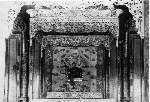
Comprehending the Citadel is easier if you keep in mind that most of this enormous walled complex is simply made up of neighborhoods-streets lined with homes and shops just like in any other part of the city. People enter and leave the Citadel constanty as they go about their business, though no one can fail to recognize the Citadel’s boundaries, for you have to cross one of the bridges over the surrounding zigzag moat and pass through one of the narrow gates in the old stone walls.
What you’re in fact visiting after you pay your admission to the Citadel is the Imperial Enclosure, the smaller royal citadel within the outer walls of old Hue, and the Forbidden Purple City, the royal enclave within. When Ngoc deposited Clang and me in front of the Imperial Enclosure, a soccer game was going on across the street, at the base of the Flag Tower, a stark black pyramid topped by a tall staff, from which Vietnam’s gold-starred red banner limply hung. Just beyond, the Perfume River glided past in a gentle curve. Grouped on either side of the Flag Tower are nine large ceremonial cannons, cast from itemsof bronze confiscated by Emperor Gia Long from the Tay Son forces he defeated in establishing his dynasty.

Gia Long’s humiliation of his enemies reached greater heights than taking away their bronze ware: He reportedly dispatched one predecessor by having him ripped apart by elephants. In 1802, to commemorate the founding of the new dynasty, Gia Long ordered the excavation of the corpses of two Tay Son kings. Gia Long had the corpses ground to powder and scattered. The kings’ skulls, however, he put in prison. The skulls were shackled in separate rooms, and a delegation checked on the “prisoners” once a month. The prison where the Tay Son skulls were interned still exists, in the far northwest corner of the Citadel-today the home of the Tay Loc elementary school.
Giang and I crossed the wide stone bridge Leading to the entrance to the Imperial Enclosure. Lotus plants choked the shallow pools on either side of the bridge. Access to this part of the Citadel where the emperor lived and worked is through the Noon Gate, a schizophrenic structure if ever there was one, half fortress, half frill: Sheer-sided brick and stone ramparts, weathered a motley black, rise up from the water, as forbidding as a prison wall; above this foundation-seeming to float on multiple columns-is a graceful two-tiered pavilion of red and yellow Lacquered wood and green and yellow tile, the roof ridges undulating with carved dragons. The gate’s upper portion–the Pavilion of Five Phoenixes-was where the emperor issued the lunar calendar each year, and it was here that Emperor Bao Dai proclaimed the end of the Nguyen dynasty, surrendering the 22-pound golden seal of the empire, a treasure whose whereabouts is still unknown.

Beyond the Noon Gate we entered the broad, stone-paved Great Rites Court. Across the way stood a hall with red-lacquered doors and a yellow-tiled roof topped by more writhing dragons–the Palace of Supreme Harmony, or Throne Palace. Emperor Gia Long was crowned inside the Throne Palace in 1806, and this was where he and his successors met twice monthly with top-ranking mandarins to discuss affairs of state. Lesser mandarins assembled in the court outside as they waited to pay homage to the emperor.
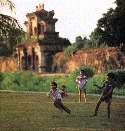
In the palace’s central chamber, the emperor sat upon an elevated red and gold throne, resplendent in a golden robe girdled with a belt of jade and wearing a crown decorated with dragon designs. The ThronePalace’s glory–and paint–are a little faded now, but the fact that the building preserves even a semblance of its former splendor is due to a major effort to repair the damage done by shelling in 1968. At the rear of the Throne Palace lies a courtyard containing the Halls of the Mandarins, pavilions in which officials made themselves presentable prior to court ceremonies. The pavilion on the left now houses a souvenir shop, where I bought a guidebook to the Citadel. Nearby was a room containing a throne mounted on a red and gold dais; for two dollars anyone could don imperial garb and have their picture taken sitting there like some ersatz emperor–a genuinely silly prospect for a Westerner but something Vietnamese visitors were taking great pleasure in. Beyond the Halls of the Mandarins was the saddest spectacle in the Citadel the rubble-strewn field that now occupies most of the grounds of the Forbidden Purple City. As the sun poured down on the open meadow, I wandered among the foundations of the palaces where the emperor and his family had once lived. Plots of vegetables were growing where the emperor had dallied with his concubines. Women in conical hats tugged at weeds among the plantings. Toward the back of the compound were the remains of an expansive outdoor stage of stone, where royal entertainments had been held. I climbed the steps to the stage, now a pitted, weed-grown ruin. From there the view extended all the way back to the Halls of the Mandarins area, several score yards away there was nothing left between.
Among The Fallen Emperors
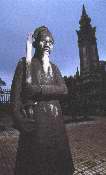
Scattered across the countryside south of Hue are the royal tombs of the Nguyen dynasty emperors. Most were planned or even built by the rulers they honor, and they all share a number of characteristics: a courtyard with statues of mandarins paying tribute to the emperor; a stele pavilion holding stone tablets detailing the emperor’s virtues and accomplishments (both real and imagined); and a temple for the worship of the emperor and his empress. The sepulcher itself is usually of a style reflecting the personality of the emperor.The three most interesting tombs are those of Cia Long’s son Minh Mang, who ruled from 1820 to 1840; the handsomely landscaped tomb of Tu Due, who ruled from 1848 to 1883; and the garish, mosaic-encrusted tomb of Khai Dinh, ruler from 1916 to 1925. I planned to set out for the tomb of Minh Mang in the early morning, traveling on the Perfume River–a boat trip of a little over an hour. At a landing not far from my hotel, I hired a dragon boat, one of the brightly painted barges named for their carved figureheads. For $15, the captain and his young son would ferry Giang and me downriver, ensconced on benches under an awning in the bow and plied with semicold Pepsi-Colas. After casting off, we skirted the shore for a short distance, passing an inlet ringed with sampans. Many of the vessels had small Buddhist altars on their roofs, some with jess sticks smoldering in incense holders. A communal TV antenna was attached to a post sticking up from the water, with wires leading to several adjacent sampans. I had an incongruous vision of these people huddled around their sets at night watching Bonanza. Our boat eased away from the bank, and soon we were cruising down the center of the Perfume River, at this point several hundred yards wide. Unlike the turgid waters of the Red River up north, the water here was surprisingly clear, a bottle green thanks in part to the river’s sandy bed. That sand provides a livelihood for any number of Hue families: We passed sampans heaped with river sand, dredged from the bottom by divers using shallow pans. The divers, many of them teenage boys or girls, pile the sand so high that- only three or four inches of freeboard remain. The families then up anchor and haul their cargo into Hue, where the sand is sold for use in construction. It was pleasant to be out on the river before the heat of the day. A cool breeze came off the water as we scooted along. It felt as if we were part of a primitivist painting, executed in bold strokes of emerald and blue the glassy green water stretching ahead, the riverbanks billowing with plant life, a cloudless sky knitting the horizons. About 20 minutes into the trip, we stopped to visit the Thien Mu Pagoda, which crowns a hillside on the north bank of the river a couple of miles west of the city overlooking a scene that a Hollywood set designer might have conceived of as the epitome of the Orient a century ago. The river stretched away to the west, winding out of sight between lush green gardens hugging the shore.
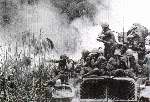
In that same direction, ranks of low blue mountains rippled away to the horizon. It was as pure and peaceful a slice of pastoral Vietnam as you’re likely to see. At the top of the flight of steps leading to the pagoda, two Buddhist novices were sweeping the grounds with palm-frond brooms, their young faces as serene as a still mountain lake. Thien Mu was founded in 1601, and the current pagoda built in 1844 has become a symbol of Hue, an icon as famous in Vietnam as Pisa’s canted tower is in the West. Likenesses of the redbrick structure appear on everything from T-shirts to teacups. Some 70 feet in height, the pagoda consists of seven octagonal tiers, each successive layer a bit smaller than the last a skinny, precariously tall wedding cake. Over the years, Thien Mu has served as more than tourist icon. In the 1960s, the pagoda wasthe symbol of Buddhist protests against the Diem regime. South Vietnam’s Catholic dominated government had a history of persecuting Buddhists, and in response, one of the monks of Thien Mu undertook a form of protest that shocked the world. On June 11, 1963, a 66 year old monk named Thich Quang Duc had a fellow monk douse him with gasoline in a busy Saigon street. He then set himself afire. The grisly scene was photographed by Associated Press correspondent Malcolm Browne. The govern ment’s subsequent crackdown on the Buddhists led to the evaporation of U.S. support for President Diem.
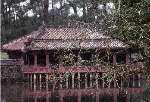
Behind the main sanctuary at Thien Mu, which contained a large gold-colored laughing Buddha, I came upon a curious sight an old blue Austin motorcar, sitting up on blocks in an open garage. A fading photograph was attached to the car’s windshield. It was a copy of Malcolm Browne’s picture showing Thich Quang Due’s self-immolation. The photograph had been taken just moments after the fire was lit; flames were leaping several feet in the air. In the middle of this inferno sat the monk, his face registering a strange repose. A sign on the Austin announced that it was this vehicle that had borne Thich Quang Duc to Saigon.
Nearby, in the peaceful garden behind the sanctuary, the monks were tending their vegetables, oblivious to visitors. During the protest over Diem’s repression, some 30 monks and nuns had burned themselves to death. It was hard to fathom the surety of faith that would allow these gentle acolytes to undertake a sacrifice so horrible in nature.
On the boat again, I found each river mile carrying me further back in time. Scenes of unchanging Vietnam kept materializing on either shore. We passed clutches of women doing laundry at river’s edge, and bathers with sudsed-up hair standing waist-deep in the water. Farmers in shorts and conical hats tended their gardens with slow, purposeful movements. Now and then we passed fishermen hauling up submerged bamboo traps to check on their catch. Everything was utterly peaceful, the faultless skies and quiet water, the tranquil, unhurried lives displayed along the shorelines. Then suddenly much too soon we were easing up to the bank next to the pathway that leads to Minh Mang’s tomb.
Approaching the tomb, we came upon a young Vietnamese man taking a photograph of his sweet- heart. The girl sat on the paved courtyard in front of the peeling reddish plaster walls of the entry gate, her long hair draped across one shoulder. The lustrous yellow silk of her ao dal stood out sharply from the old gray stones. A profusion of greenery framed the scene. That set piece of everlasting stone, the self- renewing fecundity of nature, and the evanescent beauty of the girl spoke volumes about this land that has seen so much turmoil and grief. Always there, against the backdrop of war or disaster, you can sense the lengthy lineage of Vietnam, its land and its people, extending backward and forward, the present in fragile equipoise between.
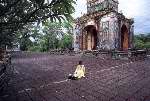
Inside the entryway, I found Minh Mang’s tomb to be grand though not gaudy a balanced, linear arrangement. At the rear of the honor courtyard, three staircases lead to the stele pavilion, after which comes a succession of three terraces leading to the temple dedicated to the emperor and his wife. Beyond the temple, three stone bridges cross the Lake of Impeccable Clarity. Another three terraces lead to a pavilion from which you can look across the crescent-shaped Lake of the New Moon to Minh Mang’s burial place a large earthen dome enclosed by a circular stone wall and covered with shrubs and pines.
After the architectural pomp leading up to it, this natural sepulcher comes as a surprise. I wondered what sort of man would choose for himself such an unassuming resting place. You couldn’t help concluding that Minh Mang was certain enough of his place in Vietnamese history that he didn’t need to indulge in self-glorification. He was, after all, one of the last emperors to rule a truly independent Vietnam. I could feel the force of the man’s personality reach out across the years.
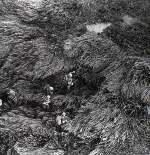
We walked down to the foot of the bridge that crosses the Lake of the New Moon. Lily pads covered the surface of the lake. Next to the water stood a tree resembling a magnolia, a su tree Giang called it. Its fragrant white blossoms littered the paving where we stood. Doves cooed in the tree. Several Vietnamese tourists sauntered toward us across the bridge, the women dressed in their Sunday-best ao dal. (According to Giang, the ao dal was first worn in the time of Minh Mang.) The group paused at the foot of the bridge. One of the men stepped forward and began taking his companions’ picture, with the sepulcher in the background.
“The Vietnamese like to have their picture taken here:’ Giang said. “Minh Mang was a patriot, you see”.
Night On The River Of Perfumes
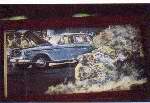 Giang spoke of another patriot as we drove past a two-story white structure directly across the riverfrom the Citadel’s Flag Tower. “That was where Ho Chi Minh went to school:’ my young guide notedcasually, “the Quoc Hoc Secondary School:’ I’d read about Quoc Hoc, once one of the most famous secondary schools in Vietnam, attended by sons of the well connected. Not only Ho studied there, but also his future commander-in-chief Vo Nguyen Clap and future North Vietnamese prime minister Pham Van Dong. It’s perhaps not surprising that none of the Communist leaders of Vietnam were members of the proletariat, but the irony is that they were attending a school run by the father of Ngo Dinh Diem, the future president of South Vietnam, who was also a student there. The four later-to-be- famous figures had been students at different times, so there was no wrestling in the aisles or schoolyard brawls among them. Their political philosophies would hardly have been mature anyway, though Ho did display his sympathies for the Vietnamese peasants by supporting a local farmers’ protest in lf)08. Today’s Quoc Hoc school is no longer in the business of turning out political firebrands. It’s beenconverted to a coeducational high school teaching vocational subiects. Just as well. Vietnam could dowith more good auto mechanics and electricians and fewer party diehards.
Giang spoke of another patriot as we drove past a two-story white structure directly across the riverfrom the Citadel’s Flag Tower. “That was where Ho Chi Minh went to school:’ my young guide notedcasually, “the Quoc Hoc Secondary School:’ I’d read about Quoc Hoc, once one of the most famous secondary schools in Vietnam, attended by sons of the well connected. Not only Ho studied there, but also his future commander-in-chief Vo Nguyen Clap and future North Vietnamese prime minister Pham Van Dong. It’s perhaps not surprising that none of the Communist leaders of Vietnam were members of the proletariat, but the irony is that they were attending a school run by the father of Ngo Dinh Diem, the future president of South Vietnam, who was also a student there. The four later-to-be- famous figures had been students at different times, so there was no wrestling in the aisles or schoolyard brawls among them. Their political philosophies would hardly have been mature anyway, though Ho did display his sympathies for the Vietnamese peasants by supporting a local farmers’ protest in lf)08. Today’s Quoc Hoc school is no longer in the business of turning out political firebrands. It’s beenconverted to a coeducational high school teaching vocational subiects. Just as well. Vietnam could dowith more good auto mechanics and electricians and fewer party diehards.
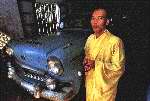
By the time Ngoc dropped me back at my hotel it was time to make plans for the evening. I’d already taken my obligatory pedicab ride around Hue the night before, rolling across Phu Xuan Bridge in thedarkness, the Citadel’s Flag Tower lit up like a Christmas tree off to the left. On quiet side streets,parents sat on chairs pulled onto the sidewalks, their children scampering around them. Pairs of bicyclistsrode leisurely past my pedicab, chatting and joking, sometimes holding hands, seemingly on their way tono place in particular. The shops all around were full of goods. The feeling of contentment was pervasive.At the Citadel, the pedicab driver had rung his bell as we’d passed through the gate of the old city, the jing-jing echoing off the stones of the narrow passageway. Beyond the gate we’d glided through a park where dozens of lovers sat on benches and foleing chairs, clinging to one another in absolute darkness, as motionless as statuary, utterly silent. It was that moment that I’d felt the real magic of Hue. And now, I decided, what better way to end my stay here than with an evening cruise on the PerfumeRiver? At the hotel’s activity desk I chartered a golden-prowed draon boat, along with a four-pieceensemble to perform traditional songs of Hue. Giang and I met the boat at the dock in front of the hotel just as the lights of town were flickering on. The 30-foot craft was poered by a single oar in the rear, so no engine noise would interfere with the music. We clambered down into the passenger compartment,which had a low roof and open windows along each side. A number of lanterns filled the compartment with a warm yellow glow. There were no chairs or benches, merely rush mats covering the floor. Already seated were the four musicians, three women and a man, each in an ao dai-one woman in pale blue, one in yellow, one in apricot, and the man indark blue. They bowed as we removed our shoes an tucked our legs beneath us on the floor. As the boatman shoved the barge away from the dock, the musicians launched into a sprightly melody. The man was playing a dan nguyet, the long necked, two-stringed moon-lute. A 16-stringed zither was played with nimble ease by the woman in the yellow ao dal. The two other women were singers, though they added percussion notes from time to time with clacking teacups and wooden sticks. After the first song, one of the performers explained what the words conveyed. It was a song to welcome guests to Hue and praise the beauty of the city. The group performed one song that told of two lovers who were separated when the man had to go away to war; the woman is sad,lovesick. Another song spoke about the joy of a native of Hue returning home after an absence. The hoofbeats of the traveler’s horse were wondrously rendered with a pair of teacups by one of the singers. During each of thesongs, I followed the long, elegant fingers of the tither player. They fluttered over the strings of herinstrument, sometimes strumming, sometimes plucking, sometimes hammering out the notes. I quickly lost track of the time as we drifted through the darkness in our little capsule, the musicrippling out into the night, the lights of the city glittering on the river. After the musicians had performed several songs, they put aside their instruments for a moment and began lighting candles inside a number of square-shaped lanterns made of colored construction paper. The flames showed through the sides of the lanterns, glowing in pale rose, soft lemon, aqua. One of the singers handed me a lantern, speaking to me in Vietnamese. “She says you should put it on the water: Giang explained. I leaned out the open window and placed the floating lantern on the water while the woman continued speaking. “This is what the emperor did when he traveled by boat:’ Giang interpreted. “It was a symbol of his desire to spread wealth and happiness to his people. You are supposed to make a wish when you place one on the water. The woman kept handing me the lanterns until I’d launched every one, a dozen in all. Afterward, the musicians returned to their places and resumed their playing. I watched the lanterns trailing slowly away.
Pass Of The Ocean Clouds
Though the road between Hue and Danang covers only about 70 miles, it takes more than three hours to traverse it. Between those cities, National Highway 1follows a tortuous route through an east-west spurof the Truong Son Mountains. Cutting all the way across Vietnam’s skinny midsection, the mountains here form a barrier that divides the country climatically. North of the mountains the weather is cooler, with frequent typhoons and floods, while to the south the weather remains tropical year-round. That east-west mountain barrier divides Vietnam in one other significant way. Facing typically cold winters and other harsh conditions, northern inhabitants have evolved a temperament much like that of a frugal New Englander–cautious, straightlaced, eternally prudent. Southerners, able nearly to live off the fat of the land, are a more open and easy-going people, more hot-blooded than their northern kin. Even the food in the north tends to be more conservative, the flavors less fiery than in the south. We drove out of Hue with the golden light of morning spilling across the awakening countryside. A short distance from town we came upon one of those ghostly reminders of America’s prior investment in Vietnam the remains of the Phu Bai Marine air base, still in use as a civilian airport.

We passed buildings in various stages of dilapidation, an assortment of tired-looking Quonset huts and maintenance sheds and operations centers. The structures appeared to be slowly settling into the sandy ground, weighed down by time and the elements. Those relies of war were quickly behind us, and we were rolling on through miles of paddy country,green and level fields butting up against a mass of inland mountains off to our right. The railroad runs alongside the highway here. Before long both asphalt and steel were edging around a large lagoon, identified as Dam Cau Hai on my map. A couple of dusty towns came and went, and then we were driving out over the water on a long spit of sand, a blue-green lagoon to~our right and the South China Sea to ourleft. Small fishing boats flecked the water on either side of the road.
It was mid-morning when we stopped for a rest in the fishing village of Lang Co, at the tip of the spit we’d been traveling on. A string of fishermen’s shanties spread out along the road beneath a canopy of coconut palms. There was an unpretentious hotel and a few beach houses for rent. In the scatcering of small cafes’ you could indulge in the local seafood. Ngoc pulled up at a humble eatery nestied among the trees in back of the beach. We sat down outside and ordered cold sodas. Inevitably, we were quickly surrounded by children and peddlers. Ngoc bought a bag of nuts and began munching away. For some reason, Clang chose that moment to tell me that Ngoc had four children of his own, but that by law only two were permitted to be covered by “social welfare.” I don’t think Ngoc understood enough English to know precisely what Clang was saying about him, but he smiled anyway. Ngoc’s front teeth were edged with gold.
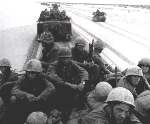
I finished my drink and took a stroll down a sandy path leading to the beach. We were in the heat of the day by now, and hardly anyone was to be seen, though I doubt that at its busiest the beach here ever sees more than a handful of people at a time. Toward the south end of town, a spidery bridge tethered the skinny peninsula to the mainland,where the road curled into the mountains that reared up out of the sea. That was where we were heading. That twisting, climbing section of Highway 1 would lead us to Hai Van Pass, the Pass of the Ocean Clouds.(The train chickened out here; it continued to hug the shoreline, ducking in and out of tunnels on its way around the mountains.)

A few minutes later, our trusty Peugeot its transmission whining labored up the road I’d seen from the beach. At Giang’s suggestion, we stopped on a wide curve that presented a scenic overlook. As soon as I got out of the car I recognized the view it was a Kodak spot, the vantage point from which all the photos of Lang Co that you see in guidebooks are taken. During my travels in Vietnam I encountered many scenes of surpassing beauty, but at Lang Co, the setting was nearly perfect. The narrow peninsula’s pale, virginal beaches were lapped on either side by the turquoise waters of the lagoon and sea, and beyond the lagoon, the brawny, emerald-clad mountains marched away to the north in an irregular procession.
Just below us, the little fishing village drowsed in the sunshine, the stark white spire of its old Catholic church poking up from the trees. If a beach front paradise exists in Vietnam, then surely this is it. Lang Co was one of those lonely outposts where a handful of people quietly go about their lives surrounded by nature extravagant and pure. You won if such people have any sense of the sublime beauty of what, to them, is just their everyday surroundings. I pondered how much longer Lang Co would retain its peaceable air; someday that venerable church steeple down there will likely be lost among the glitter of resort hotels.
I heard a commotion behind me. Three child peddlers came scuttling across the road, holding trays of goods and shouting, “You buy, you buy.” I’d grown so used to saying no–no to trinkets, gum, postcards, headache salve, what have you that I almost failed to notice the antique silver coin one girl held out. I took the coin to examine. It was the size and heft of a silver dollar. On one side were the words “Indo-Chine FranCaise Piastre de Commerce:’ On the other a female figure sat above the date, 1896.
It dawned on me that what this girl was actually offering was a totem of her country’s stormy history over the past one hundred years. During that coin’s existence, the Vietnamese had fought the French, the Japanese, the Cambodians, the Chinese, and, of course, the Americans. Who could guess where the coin had been over the years? It might have bought a night’s pleasure in a Saigon brothel for a young French soldier, or jingled in the pocket of the rich owner of a rubber plantation in the Central High lands. It might have paid for opium in Dalat, or rice in the Mekong Delta, or arms for the Viet Minh. And now it had found its way into my hands. I gave the young peddler her asking price, one U.S. dollar, and pocketed the coin. It would be my lucky charm for the remainder of my trip. Then it was back in the car to continue grinding upward. The elevation of the pass is only a little above 1,600 feet, but when approaching from the north, you climb to that height from sea level over a distance of about ten miles the reason for the broken-down buses and trucks along the side of the road. There were frequent turnouts with water for overheated vehicles; every one of them we passed was in use. A number of boulders had tumbled onto the highway, and several roadside shrines marked spots where travelers had died.
“Anyone who must drive here at night first stops to pray that they will make it safely:’ Giang said over his shoulder. That sounded like a good idea during the day time, too.
The Peugeot groaned around hairpin turns, often with precipitous drop-offs just beyond the edge of the road. I was glad I wasn’t driving and that Ngoc had made this run so many times before that he wasn’t tempted to do any rubbernecking. When we finally reached the pass, Ngoc pulled over at the small truck stop where drivers can let their engines cool down. Clusters of entrepreneurial youths were busy washing trucks to make a few dong.
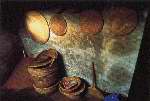
A gray, crumbling French pillbox commanded the pass alongside the highway. The Americans had built a low concrete bunker nearby. My guidebook warned not to go tromping around these fortifications; there were supposedly live mortar shells left lying about. I didn’t feel like testing the accuracy of the claim, so I stepped over to the roadside near the truck stop to check out the view. A mist hovered over the pass, but the long golden curve of Nam O Beach was still visible far below to the south, and in the distance, the high profile of Monkey Mountain marked he outskirts of Danang, some 20 miles away by road. Straight down the mountainside, trucks were crawling their way upward like ponderous beetles.
As I jotted a few notes, the usual vendors began homing in on me, three pretty teenage girls this time.After I’d waved off their offers of Pepsi and bottled water, one of the girls shoved her face next to mine and began reading my notes to her friends. The three of them seemed to get a great deal of amusement from my writing. The girl doing the reading stood back and smiled at me good-naturedly. She seemed to be sizing me up. Suddenly she prodded my stomach. “Beaucoup bia-Lots of beer,” she pronounced.
Ngoc pulled the cooled-down Peugeot over to the edge of road behind me and beeped the horn. I waved goodbye to the three young vendors, and we immediately began switchbacking down from the heights. Before long we were back on the sandy flats, following the blue curve of Danang Bay toward Monkey Mountain. As we pulled into Danang, I was reminded of the streets of Hanoi by the incredible piles of odds and ends along the road, the sheer junkiness of things.
Several old U.S. Army trucks were bouncing along the streets, painted in bright colors now, recycled as commercial vehicles. This had been one of the major U.S. bases in Vietnam, headquarters for I Corps and a major port for the war effort. Historically, Danang figured prominently in the conflicts of this century and the last: It was here in 1965 that the first American combat troops slogged ashore; 118 years earlier, Danang was where French forces began their military assault on Vietnam.
During the American era, Danang rode high on the profits from servicing the immense military machine. After the Americans left, however, Danang’s fortunes took a nosedive, hitting bottom in l975, when, as South Vietnam’s defenses crumbled, the city was swept by a firestorm of violence. A million refugees poured into the city overnight. Panicked soldiers and civilians, trying desperately to flee the advancing Communist troops, battled for space aboard the few boats and aircraft available for evacuation. That reign of terror, and the cold-turkey suspension of American largess, left Danang down and very nearly out a destitute, down-at-the-heels, dispirited place.
Perhaps because of its legacy of capitalism, Danang has been quick to put the country’s economic reforms into practice. Vietnam’s fourth-largest city (population 600,000) and still one of the country’s major ports (it also serves as southern Laos’ outlet to the sea), Danang is positioned to become the hub for development along the central coast. The lush Central Highlands at Danang’s back and the pristine beaches north and south of the city are certain to attract increasing numbers of tourists. And just down the coast from Danang is Hoi An, a sleepy town that from the 17th century to the 19th was one of Southeast Asia’s busiest trading centers, on a par with Macau and Malacca until its link to the sea, the Thu Bon River, silted up and became too shallow for oceangoing craft, allowing Danang to eclipse it as a port. Hoi An had the distinction of being the first place in Vietnam that Christian missionaries visited. (Back then, the town was known as Faifo.) Among those proselytizing foreigners was Alexandre de Rhodes, the 17th-century French priest who invented the Latin-based script for the Vietnamese language.
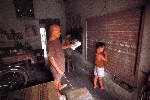
In Hot An’s heyday as a port, ships from around the world sailed up the Thu Bon River, vessels from Holland, Portugal, France, Spain, China, Japan, Thailand, even America. Traders journeyed here to buy silk, porcelain, tea, and other goods. The Chinese and Japanese merchants who called here were forced to lay over from spring until the summer, when the prevailing winds would carry them back home. Eventually the merchants began leaving year round representatives in Hoi An, the start of the foreign colonies that were to give the town its distinctive architectural flavor. Along the narrow streets, merchants built tiny tile-roofed shops, warehouses, and homes reminiscent of those in old Hong Kong. The Chinese erected several fine temples and can halls (Vietnam’s ethnic-Chinese still come to Hoi An for celebrations). The ornate Japanese Covered Bridge linked the town’s Chinese and Japanese quarters. Miraculously, Hoi An managed to escape significant damage during the Vietnam War. Parts of it look just as they did two centuries ago, giving the town the feel of a living museum. Inside private homes and shops you can still see beautifully carved wooden interiors, stained dark with time. The pagodas and assembly halls are alive with flamboyant tile work. Best of all, though, is the peacefulness of the place. It has the unhurried, unselfconscious air of a town that doesn’t yet realize its own charms.
Sand And Sanctuaries
Danang’s most famous landmark, of course, is China Beach, the miles-long curve of bright white sand and blue, blue water familiar to the thousands of American soldiers who spent R&R here in the ‘6Os and early ’70s. China Beach is relatively undeveloped as of now. From the car park of the Non Nuoc Hotel, I walked past a cluster of changing rooms to an outdoor cafe nestled in a line of pine trees back of the beach. In either direction along that stretch of sand there were maybe 20 people, a few fishermen, a handful of sunbathers, three child peddlers holding trays of seashells. Off to the north, the green bulk of Monkey Mountain marked the emphatic end of Danang’s southern stretch of beaches.
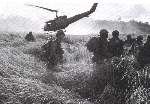
Down by the water, I stopped to observe two Vietnamese newlyweds, still in their finery. They were frisking along at the edge of the surf, the groom with his shoes off and his trousers rolled up to his knees, the barefoot bride daintily holding her gown out of the water. The two were mooning and mugging for a video cameraman who was busy preserving these first moments of marital bliss.
Directly behind China Beach loom the isolated limestone outcrops of the Mountains of the Five Elements, more commonly known as the Marble Mountains. From these five large rock formations–one-time islands–comes the red, white, and blue green marble used by local carvers for tombstones and the ubiquitous objets d’art for sale at kiosks at the beach, in Danang, and all around the Marble Mountains themselves. (The stony hills also supplied building material for Ho Chi Minh’s mausoleum in Hanoi.)
The Marble Mountains happen to be honey combed with caves, which, during the war, made convenient hiding places for the local Viet Gong.Throughout all the years that American soldiers were resting and recreating at China Beach-lolling about on the sand, surfing, making the acquaintance of the local female population the VC were vigilantly looking down on them from the heights, taking occasional potshots at their enemies.
But long before the Viet Gong sought shelter here, these caves provided sanctuaries of another sort. Over the centuries, the stone chambers have served as religious shrines, with numerous sacred icons carved into the walls of living rock. When this area was controlled by the Cham people, from the late second century into the 1400s, sanctuaries were dedicated to Hindu gods. Later, Buddhist and Confucian shrines were built. The largest of the five hills, Thuy Son (Water Mountain), contains the best examples of those ancient places of worship. The Vietnamese still make frequent pilgrimages to the sanctuaries of Thuy Son. To see these holy places and to get an inkling of what China Beach looked like to those wartime cave dwellers. I started climbing the intimidatingly steep stone stairway Leading up the mountain.
Along the first part of the stairway, knots of war casualties sat on their haunches, hands outstretched. Passing those clusters of blinded, maimed souls was like negotiating a living version of the Stations of the Cross.
There are supposedly 157 steps on the staircase ascending the mountain. I didn’t count, though my legs had turned to rubber by the time I reached the most memorable of the caverns, Huyen Khong Cave.>When I stepped inside the shadowy recesses of the cave (a flashlight is a definite asset on this trek), my eye was immediately drawn upward. From several holes in the roof high overhead, shafts of light slanted down through clouds of joss smoke, illuminating a large sculpture of Buddha carved high on one wall. There were also shrines to Confucius, and several inscriptions had been hewn into the rock.
During the war, the VC had used this large, gloomy chamber as a field hospital. I shuffled around the gritty floor of the cave, thinking about what it must have been like to lie here wounded. It couldn’t have been a very sanitary medical facility, but the inspiring panoply of religious figures that a soldier would have seen from his cot must have been some comfort. On the wall of the cavern was a plaque dedicated to the Women’s Artillery Group, whose members in 1972 managed to destroy 19 Marine aircraft parked on the field at the base of the mountains. That testimonial seemed out of place amid the spiritual surroundings, but then it’s legitimately part of the history of this ancient sanctum.
From Huyen Khong Cave, I stepped out into the piercing sunshine and followed the pathway to the Linh Ong Pagoda. Crouched against the side of the mountain, the recently rebuilt sanctuary is fronted by attractive grounds. The shady orchid garden is a restful spot from which to look out over the sea. Unlike the dusty, rock-carved sanctuary of Huyen Khong Cave, everything here was out in the open, washed by the sun, as clean and bright as a porcelain sink. There was a large white Buddha outside the ornate new pagoda. Another figure sported a mon strous, Mick Jaggeresque tongue.
I marshaled my energy for an assault on the billy-goat pathway leading up to the Vong Hai Da scenic overlook, a nearby promontory affording an unobstructed view of China Beach and the South China Sea. A few minutes later I stood on the rocky ramparts, gazing down at the slumberous sands lapped by the gentle surf. There were a number of good-size boulders around the overlook, convenient hiding places for those Viet Cong snipers. I wondered what a Vietnamese guerrilla must have thought, seeing his enemies scampering around in their skivvies. I tried to picture what an American soldier would have made of the situation if the tables had been reversed. Would the Viet Cong have been humanized by watching them at play? Not likely.
A Museum For The Ages
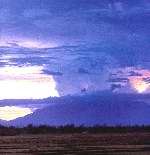 In downtown Danang, I checked into the aptly named Modern Hotel on Each Dang Street. The hotel was preternaturally spotless, all polished tile and dazzling whitewash inside and out. My second-floor room had a fine view of the Han River directly below. Out on the street, I walked south along the river toward the city’s most noteworthy sight (arguably its only noteworthy sight), a pale yellow stucco building that sits in a little tree-shaded park on the banks of the Han just four blocks away. Inside that understated one-story structure, some 300 sandstone or terra-cotta sculptures record the remarkable artistry of the kingdom of Champa, which dominated this region from the late second century to the 15th.
In downtown Danang, I checked into the aptly named Modern Hotel on Each Dang Street. The hotel was preternaturally spotless, all polished tile and dazzling whitewash inside and out. My second-floor room had a fine view of the Han River directly below. Out on the street, I walked south along the river toward the city’s most noteworthy sight (arguably its only noteworthy sight), a pale yellow stucco building that sits in a little tree-shaded park on the banks of the Han just four blocks away. Inside that understated one-story structure, some 300 sandstone or terra-cotta sculptures record the remarkable artistry of the kingdom of Champa, which dominated this region from the late second century to the 15th.
Danang’s renowned Cham Museum was founded under the French in 1915, and it had to be enlarged in 1936 to accommodate the growing collection. The museum survived 30 years of modern warfare, though not without abuse. South Vietnamese soldiers once slung their hammocks between the priceless, thousand-year-old stone carvings. During the French years, when Danang was known as Tourane, many Cham treasures were shipped out of the country to galleries or private collectors. Still, the specimens preserved here represent the finest gathering of these works anywhere.
The oldest artwork in the museum dates from the seventh century. Spread out among the four large rooms of the open-air gallery-surprisingly vulnerable to wind and rain are any number of sculptures of the female breast, representing the Cham goddess Uroja. Stone phallic symbols, along with depictions of sensual goddesses and meditative images of Shiva, Brahma, and Vishnu, confirm the influence of Hinduism on the Chams.
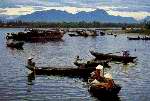
Standing among a display of animal sculptures done between the 12th and 14th centuries, I chuckled at imaginative sea monsters with great bulging eyes and a chubby figure with the head of an elephant and the body of a lion. I was intrigued by the goddess Uma, whose four arms seemed ready to entwine me if I stepped a bit closer. And there were gods with such infectious grins that they made me hanker to know more about a people who would invest their religious icons with such expressions of boundless joy. The figure I found myself most taken with was a slender dancing girl wearing a scanty costume and a demure smile. The tenth-century sandstone rendering of Apsaras captured in midstep, her arms and legs curving gracefully, seemed to make cold stone spring to life.
Evidence of the Cham kingdom still exists all over central and southern Vietnam, in the many vine-encrusted orange-brick towers jutting up around the countryside. Though heavily damaged during the Vietnam War, the finest grouping of Cham towers is at My Son, in a remote valley 3 7 miles southwest of Danang. To the seafaring, piratical Chams, these gracefully tapering brick towers were the embodiment of their religious beliefs.
If you wish, you can make an effort to sort out the many styles and periods represented by the displays in the Cham Museum, but I wouldn’t recommend it–unless you think you can keep the Tra Kieu, An My, My Son, Dong Duong, Khuong My, Chanh Lo, Thap Mam, and Yang Mum styles all straight. I found it far better lust to wander from room to room, marveling at the exuberant originality of works rendered with such passion by those artists of long ago.
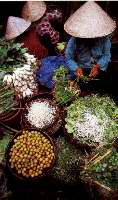
Toward the end of my visit, I took a seat on one of the benches in the small circular courtyard in front of the museum, across from a group of teenage schoolgirls who sat clustered together like doves on a sill. Dressed in white ao dal, the girls were having their picture taken. The gnarled black limbs of a magnolia tree arched above the girls’ heads, the tree’s fragrant white blossoms vivid among its waxy green leaves. The scene constituted one of those galvanizing tableaus that I witnessed in this country from time to time. The ethereal beauty of those white-clad girls so perfectly echoed the delicate beauty of the tree’s white flowers that for an instant they seemed one and the same, products of the same nurturing soil.
Back at my hotel that evening, I hailed a pedicab rolling down Each Dang Street. I needed to put Danang to the after-dinner-spin-around-town test. But as we glided up and down the streets of the city, I was frankly disappointed. While Danang may have an attractive setting, with the mountains in the distance and gorgeous beaches all around, the center city is a maze of shabby, crowded streets where people seem preoccupied and not overly friendly. Upstairs in my room, I flipped on the TV. More rocking Hindus on Channel “V:’ I tried another station a roomful of Vietnamese aerobic dancers were bounding about in tights. I switched off the set. For a few moments before turning in, I gazed out the window at the black waters of the Han River.
Early the next morning I was awakened by the sun cresting the horizon. I’d neglected to close the curtains the night before. When I got up to pull the curtains, I saw that the Han River had been transformed into a molten flow. Two inky silhouettes were rowing their ebony sampan across the flaming waters. Down in the street outside the hotel, joggers were padding along, the rubber soles of their shoes softly whapping the pavement.

